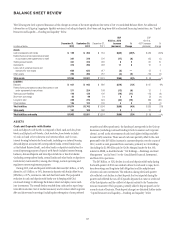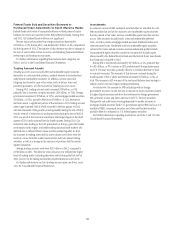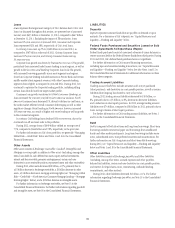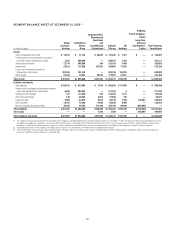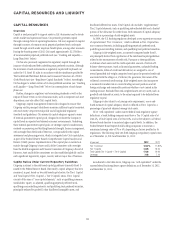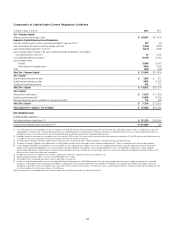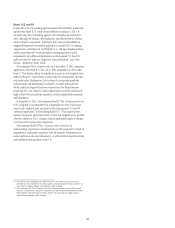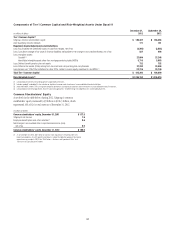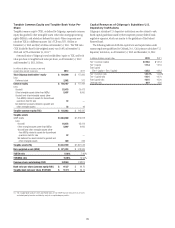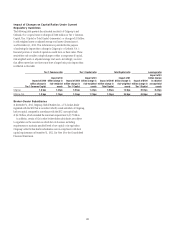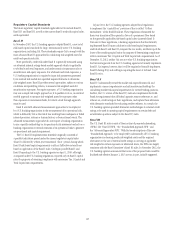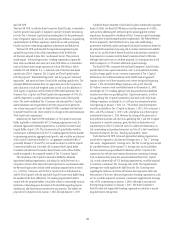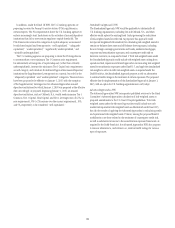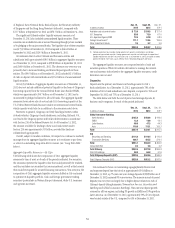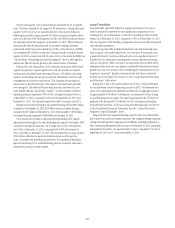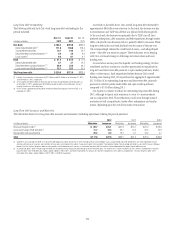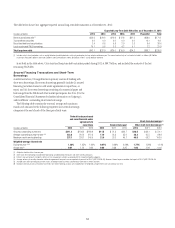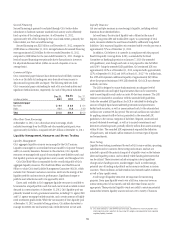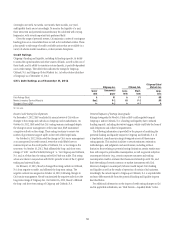Citibank 2012 Annual Report Download - page 69
Download and view the complete annual report
Please find page 69 of the 2012 Citibank annual report below. You can navigate through the pages in the report by either clicking on the pages listed below, or by using the keyword search tool below to find specific information within the annual report.47
Regulatory Capital Standards
The future regulatory capital standards applicable to Citi include Basel II,
Basel II.5 and Basel III, as well as the current Basel I credit risk capital rules,
until superseded.
Basel II
In November 2007, the U.S. banking agencies adopted Basel II, a new set of
risk-based capital standards for large, internationally active U.S. banking
organizations, including Citi. These standards require Citi to comply with the
most advanced Basel II approaches for calculating risk-weighted assets for
credit and operational risks.
More specifically, credit risk under Basel II is generally measured using
an advanced internal ratings-based models approach which is applicable
to wholesale and retail exposures, and under certain circumstances also to
securitization and equity exposures. For wholesale and retail exposures, a
U.S. banking organization is required to input risk parameters generated
by its internal risk models into specified required formulas to determine
risk-weighted assets. Basel II provides several approaches, subject to various
conditions and qualifying criteria, to measure risk-weighted assets for
securitization exposures. For equity exposures, a U.S. banking organization
may use a simple risk weight approach or, if it qualifies to do so, an internal
models approach to measure risk-weighted assets for exposures other
than exposures to investments funds, for which a look through approach
must be used.
Basel II sets forth advanced measurement approaches to be employed
by a U.S. banking organization in the measurement of its operational risk,
which is defined by Citi as the risk of loss resulting from inadequate or failed
internal processes, systems or human factors, or from external events. The
advanced measurement approaches do not require a banking organization
to use a specific methodology in its operational risk assessment and rely on a
banking organization’s internal estimates of its operational risks to generate
an operational risk capital requirement.
The U.S. Basel II implementation timetable originally consisted of
a parallel calculation period under the current regulatory capital rules
(Basel I), followed by a three-year transitional “floor” period, during which
Basel II risk-based capital requirements could not fall below certain floors
based on application of the Basel I rules. Citi began parallel Basel I and
Basel II reporting to the U.S. banking agencies on April 1, 2010, although,
as required under U.S. banking regulations, reported only its Basel I capital
ratios for purposes of assessing compliance with minimum Tier 1 Capital and
Total Capital ratio requirements.
In June 2011, the U.S. banking agencies adopted final regulations
to implement the “capital floor” provision of the so-called “Collins
Amendment” of the Dodd-Frank Act. These regulations eliminated the
three-year transitional floor period in favor of a permanent floor based
on the generally applicable risk-based capital rules (currently Basel I).
Pursuant to these regulations, a banking organization that has formally
implemented Basel II must calculate its risk-based capital requirements
under both Basel I and Basel II, compare the two results, and then report the
lower of the resulting capital ratios for purposes of determining compliance
with its minimum Tier 1 Capital and Total Capital ratio requirements. As of
December 31, 2012, neither Citi nor any other U.S. banking organization
had received approval from the U.S. banking agencies to formally implement
Basel II. Citi expects, however, that it will be required to formally implement
Basel II during 2013 and will begin reporting the lower of its Basel I and
Basel II ratios.
Basel II.5
Basel II.5 substantially revised the market risk capital framework, and
implements a more comprehensive and risk sensitive methodology for
calculating market risk capital requirements for covered trading positions.
Further, the U.S. version of the Basel II.5 rules also implements the Dodd-
Frank Act requirement that all federal agencies remove references to, and
reliance on, credit ratings in their regulations, and replace these references
with alternative standards for evaluating creditworthiness. As a result, the
U.S. banking agencies provided alternative methodologies to external credit
ratings to be used in assessing capital requirements on certain debt and
securitization positions subject to the Basel II.5 rules.
Basel III
The U.S. Basel III rules consist of three notices of proposed rulemaking
(NPRs): the “Basel III NPR,” the “Standardized Approach NPR” and
the “Advanced Approaches NPR.” With the broad exceptions of the new
“Standardized Approach” to be employed by substantially all U.S. banking
organizations in deriving credit risk-weighted assets and the required
alternatives to the use of external credit ratings in arriving at applicable
risk weights for certain exposures as referenced above, the NPRs are largely
consistent with the Basel Committee’s Basel III rules. In November 2012, the
U.S. banking agencies announced that none of the proposed rules would be
finalized and effective January 1, 2013 as was, in part, initially suggested.


